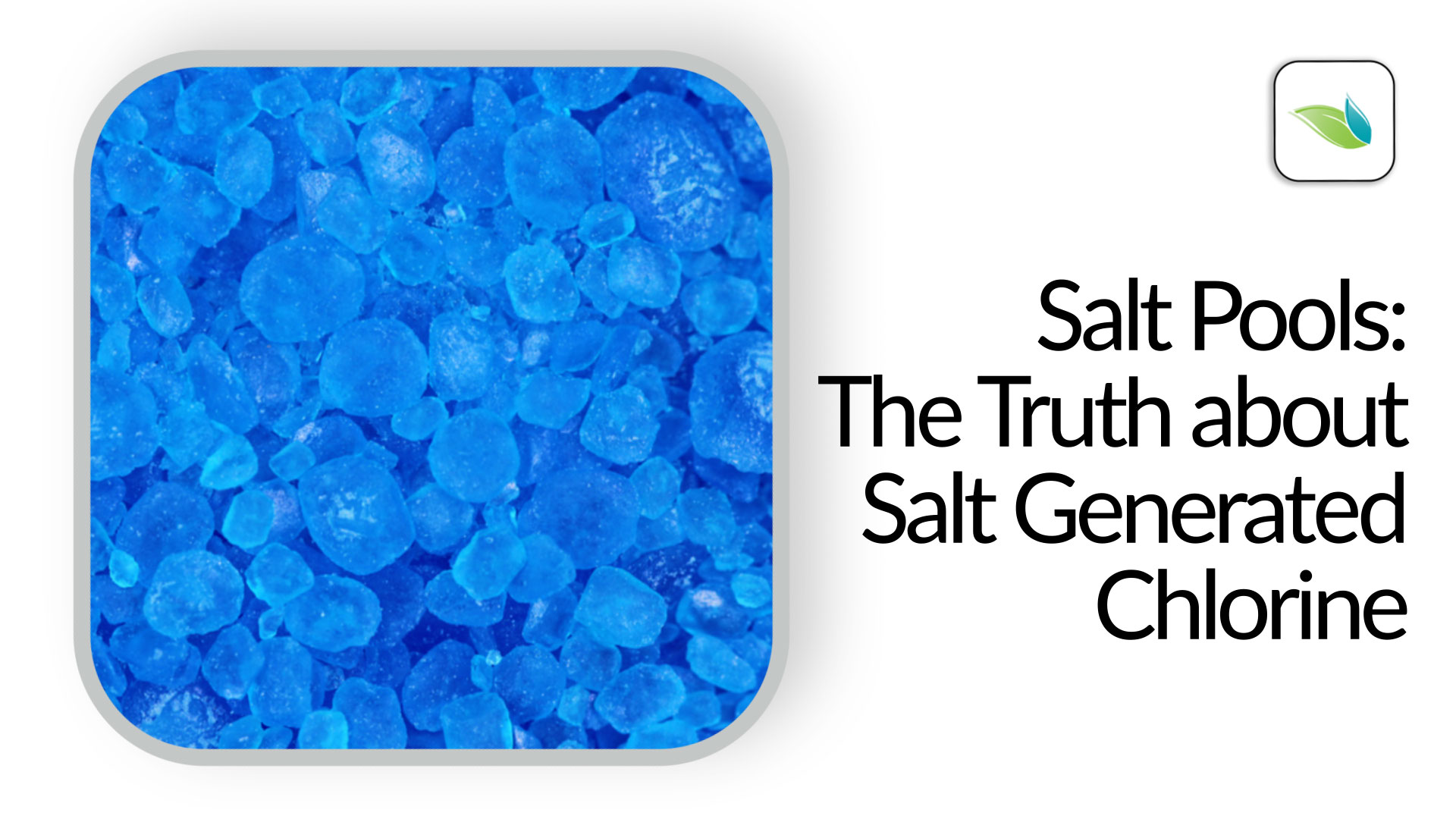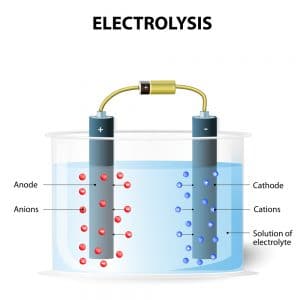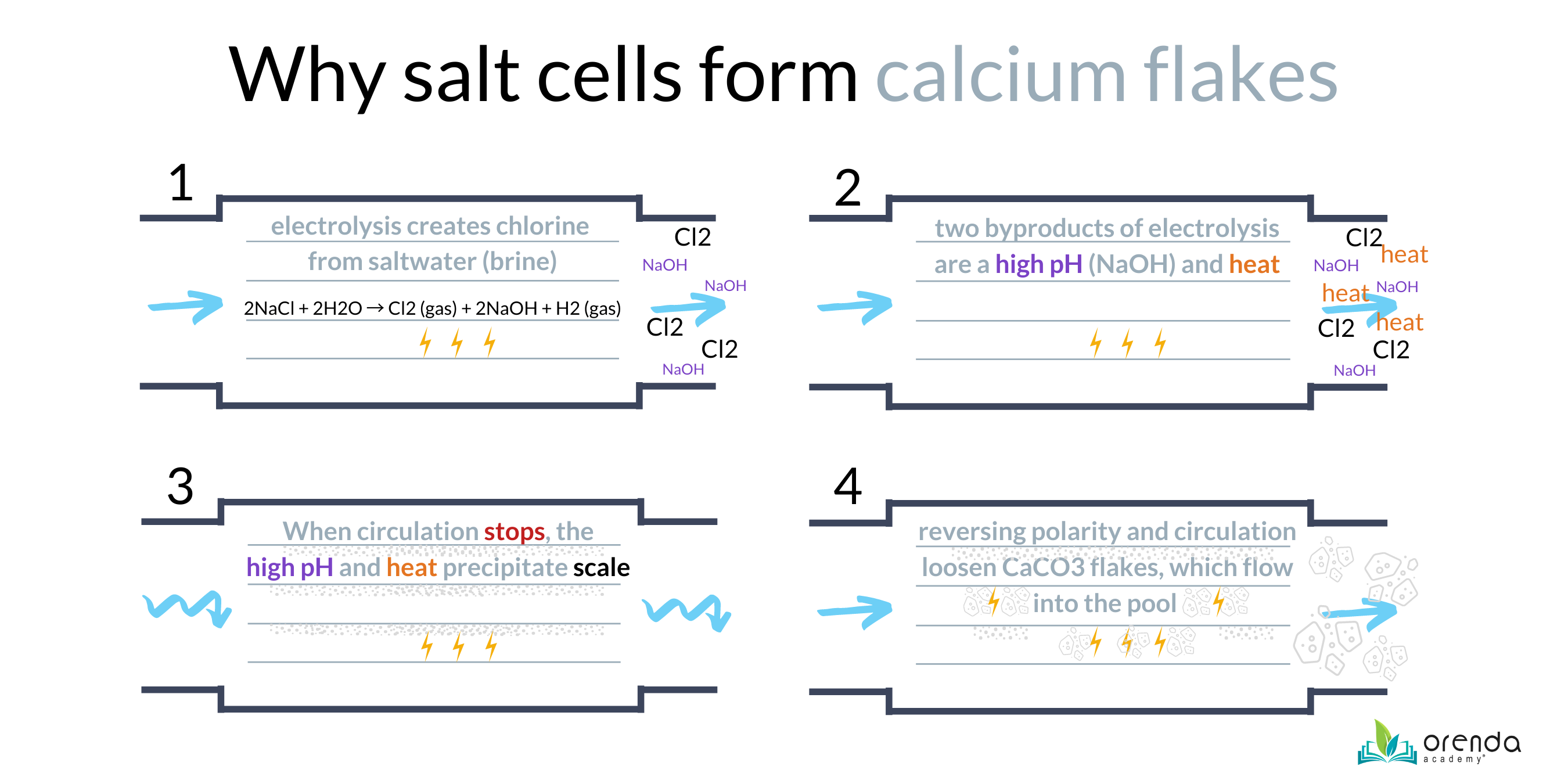Salt Pools: The Truth about Salt Generated Chlorine

Given the popularity of salt chlorine generators in residential and commercial pools, it is appropriate to share some valuable information for saltwater pool owners/operators, or those considering making the switch to salt.
We spoke with two swim school owners who are considering switching from liquid chlorine to salt. Their reasoning is due to the competitive nature of the swim school business—potential customers (parents) ask them if their pool is chlorinated because they seem to prefer their kids swim in a salt pool. Those same parents genuinely believe that saltwater means there is no chlorine in the water; a belief that, while incorrect, is widespread.
Perhaps the myth that salt pools have no chlorine in them comes from the idea that you don't need to add chlorine to a salt pool. But the truth is, yes, salt pools ARE chlorine pools.
Disclosure: Orenda does not produce/sell/distribute salt, chlorine, or any other type of sanitizer. Orenda products work with any type of sanitizer available on the market today, including saltwater. That being said, the health of pool users matters to us, as well as the sanity of pool operators. This article is meant to be informative about the facts, pros and cons of saltwater treatment.
Saltwater Pool Myths
 Myth: saltwater pools are "chlorine-free"
Myth: saltwater pools are "chlorine-free"
False. Salt systems are actually chlorine generators, using a process called electrolysis. Electrolysis happens by sending electricity through saltwater (sodium chloride, or NaCl), which interacts with the chloride ion in the salt. This creates chlorine in the water, and a very high-pH byproduct called sodium Hydroxide. The now-chlorinated water flows into the pool, and voila! You have a chlorine pool that tastes like saltwater.
You can read more on electrolysis here. To be fair, we do not know of any salt cell manufacturers foolish enough to claim their salt systems allow for a chlorine-free pool because chlorine generation is exactly what salt generators do. This "chlorine-free pool" is more of a myth that the public believes for some reason. Perhaps it's the perception that salt-generated chlorine is more natural chlorine? Not sure. But it's pervasive and false. It's actually a running joke in the pool industry.
Myth: saltwater is healthier for your skin than chlorine.
Well, again, salt pools are chlorine pools, so it depends on how this claim is worded. As we just discussed, there is chlorine in saltwater pools. So is saltwater healthier for swimmers? Saltwater certainly tastes better than a traditionally chlorinated pool, and some people may get less irritation or dryness on their skin after swimming. However, this seems to be largely subjective to people’s opinions. Some people like saltwater, others hate it. The same argument could be made for natural vs. synthetic compounds, but without scientific evidence one way or another, we are in no position to make claims. It's just opinions.
We have not found any scientific evidence that salt-chlorinated pools are any healthier for people than traditionally chlorinated pools. If you have, please send it to us. And furthermore, liquid chlorine (sodium hypochlorite) leaves behind salt too. What distinguishes a "saltwater pool" from a pool with salt in it is the actual chlorine generator system. So if pool owners want the feel of saltwater, they can have saltwater without necessarily having a saltwater chlorine generator (SWG) system in place. Liquid chlorine tends to leave behind approximately 17 ppm of TDS per gallon of chlorine in 10,000 gallons of water, 15 ppm of which is salt. It adds up over time.
Myth: saltwater pools have less chloramine problems.
False. Again, it’s still chlorine, and chloramines will still be created. Just like traditionally chlorinated pools, chloramines can still be relentless and brutal in saltwater pools—particularly with regard to air quality and corrosion. Corrosion actually is worse for salt pools for at least two reasons. First and foremost, salt itself is corrosive. Go to a beach town and look around if you don't believe us. Look at the underside of vehicles in the north, where the roads get salted in the winter. Look at the rust on everything metal near the ocean. Second, saltwater conducts electricity, so if the pool is not on a common bond, galvanic corrosion is rapid.
Saltwater: Pros
After the up-front costs of installing a salt generation system, it can be very cost-effective to operate. Since you don’t need to add chlorine every week (your salt is already in the water, and it stays there), your operating budget can be relieved a bit by using a salt generator. Salt cells do use electricity, but the amount of power consumed is nothing alarming.
Another benefit is consistency. Unlike liquid chlorine or tabs administered manually, salt generators consistently generate the same amount of chlorine. This is a double-edged sword, however, as mentioned in the cons below.
If people believe a salt pool is healthier for them, a benefit can be happier customers. Salt tends to be less irritating to eyes and skin, and has a familiar taste, rather than a chemical one like traditional chlorine. This is not because there is no chlorine, as discussed earlier, but because the taste of salt overpowers the taste of everything else in the water. Perception is everything.
Saltwater: Cons
The up-front costs of installing a salt generator system can be expensive. Remember those swim school owners we mentioned earlier? Their estimate for a new commercial system is close to $50,000 (and that’s just for a swim school!). Traditional chlorination systems cost a tenth of that, or even less.
With saltwater pools, owners are in a constant battle against corrosion both in their water system (pumps, filters, heaters, metal pipes, etc.) and indoor air (HVAC system, structural steel in the building, metal deck equipment, lights, and electronics in the natatorium). This, while not entirely salt’s fault, gives saltwater a bad reputation for corrosion. In reality, salt itself is not the problem…the problem is actually an electrical one. Timothy Petsch explains:
“I have seen corrosion in many a non-salt pool, and the cause of the corrosion is the same for traditional chlorine pools, especially those treated with liquid chlorine. So what is going on here? Well, quite simply, it is an issue of lack of and/or improper bonding of metallic pool equipment.” - Timothy Petsch
Yes, it turns out that saltwater is a conductor of electricity. Improper bonding (or lack of bonding) allows for electrical current to travel through the water to get to other metal fixtures. This process corrodes metal much faster than normal.
Consistent Chlorine Production
Remember the benefit of consistent chlorine production? It can also be considered a drawback. What happens when you need more chlorine to handle your bather load? Here’s a quote from Bob Harper, writing for Pool and Spa News:
“Since the ECG [salt system] produces chlorine at a fixed rate, it can be difficult to overcome the chlorine demand caused by a large amount of contaminants. Depending upon the magnitude of the demand, multiple manually-added chlorine shocks may be required to solve the problem.” - Bob Harper
Carbonate scale
Scale deposits are prevalent in saltwater, though it is easy to confuse dried-up salt for scale. The wet/dry effect looks very similar to carbonate scale.
Related Article: Calcium Flakes in Saltwater Pools

It’s not just in pools either…just look at a dock on the ocean, or any other body of saltwater. Look at the white film on boats, etc.. Scale in saltwater happens most commonly inside the chlorine generator itself, primarily on the metal cathodes. From there, it just spreads.
To be fair, carbonate scale happens in traditionally chlorinated pools too, but salt systems raise the pH consistently (due to the off-gassing of CO2 within the salt cell as hydrogen gas bubbles off). This constantly rising pH raises the LSI, which can lead to scale.
Tips for success with saltwater
Common bond
Combating corrosion and scale from saltwater can be difficult, but it is possible. First, if you are building a new pool and planning to use salt, make sure your architect, engineers (specifically electrical engineer), general contractor, and electrician know to bond everything together to common ground. This mistake is made too often because it is rarely understood. In fact, we heard about it because a leading pool dehumidification company, Desert Aire Corp., shared the information with us on a particular job.
Use a saltwater-compatible scale inhibitor
Being compatible with saltwater is essential in a scale-inhibitor product. Thankfully, most products in the pool industry are saltwater-compatible. Our SC-1000 is not only saltwater-compatible, but it also contains no phosphates, so it will not contribute to potential (but rare) calcium phosphate scale buildup. It gives you more grace on the LSI by keeping calcium chelated and in solution.
Zach Hansen, a technical service engineer explains:
"There are products that are generally used in pools to sequester minerals but the salt chlorine generator makes it a unique situation because of the conditions within the cell, the high chlorine levels, high pH, and heat. So homeowners and service techs need to use a product for scale that is specifically designed to withstand those aggressive conditions inside the cell.” - Zach Hansen
Regularly test and manage your pH and LSI

Hansen goes on to explain that the electrolysis process creates chlorine from sodium chloride, but it also releases sodium hydroxide (NaOH). Sodium hydroxide drives your pH level up. Additionally, the process generates more heat, which leads to more scale.
Beyond just managing the pH of your water, what really matters is the saturation of calcium in your water, as measured on the Langelier Saturation Index (LSI). Salt cells give off heat AND create sodium hydroxide. That combination makes it hard to resist scale formation within the salt cell itself. Especially right after the pump shuts off.
Simply run your circulation for 5-10 minutes after you shut your salt cell (and heater) off to minimize the risk of scale. This will allow the cell to cool down and flush out the sodium hydroxide. With variable speed pumps, this can be accomplished by programming the pump to slow down below 25 gallons-per-minute, which will disengage the pressure flow switch that activates the salt system, but also moves water through the cell slowly.
Rinse the pool area regularly with fresh water
Inevitably, saltwater will splash out of the pool and drip off your patrons. Salt leaves a white residue that will harden on surfaces around your natatorium. Give these surfaces a good rinse with the hose (not buckets of pool water) to keep this residue at bay.
Bottom line, if you’re using or thinking about switching to salt water, understand the risks and how to control them.

